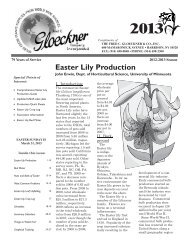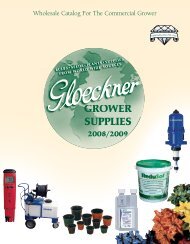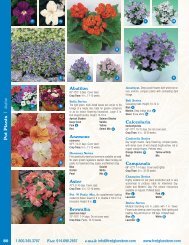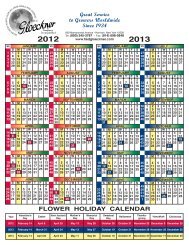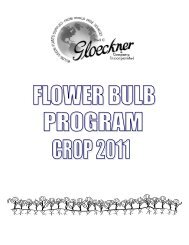Seed Catalog - Fred C. Gloeckner & Company Inc.
Seed Catalog - Fred C. Gloeckner & Company Inc.
Seed Catalog - Fred C. Gloeckner & Company Inc.
You also want an ePaper? Increase the reach of your titles
YUMPU automatically turns print PDFs into web optimized ePapers that Google loves.
Reference Materials | Snapdragon<br />
Greenhouse Snapdragon Culture<br />
<strong>Seed</strong> Germination:<br />
As a beneficial precautionary measure, particularly<br />
for Pythium control a “Root Shield” drench<br />
is highly recommended. Before sowing, drench<br />
filled seed flats using the “root shield” prescribed<br />
dosage. Allow flat to soak up liquid throughout,<br />
then immediately sow seed. Sow into an open<br />
soil-less mix with a pH of 5.5-5.8. Keep medium<br />
moist, but not saturated. Start the seeds at 70°-<br />
75°F; no warmer as snap seeds do not germinate<br />
well at higher temperatures. Keep the soluble<br />
salts low because snap seed and seedlings are<br />
very sensitive to high starter charges. Do not cover<br />
seeds, but light is not necessary for the first 4<br />
days. Then 500-800 FC is required. After 10 days<br />
lower the soil temperature to 65°-70°F. and allow<br />
the soil to dry out slightly. A feed of 75 PPM<br />
N from a Calcium/Potassium Nitrate feed should<br />
be applied. Wash the fertilizer off the leaves if it<br />
is a bright day.<br />
Drop the temperature to 60°-65°F after the 3rd<br />
week. The feed can be raised to 150 PPM N<br />
from a 20-10-20 source. Avoid any Ammonium<br />
Nitrate fertilizer on snaps, especially if the soil<br />
temperature is cool. Apply a fungicide drench at<br />
this stage. <strong>Seed</strong>lings are ready for transplanting<br />
in about 5 weeks from sowing. Do not plant too<br />
deep or pinch the tender stems with your fingernails<br />
while handling the small seedlings.<br />
Soil Preparation:<br />
Soil should have good aeration; add organic<br />
amendment as needed. As a soil amendment,<br />
“Waterworks”, can be added at a rate of 8 lbs. per<br />
100 sq. ft. in addition to regular organic amendment;<br />
it retains water yet helps drainage. Run a<br />
soil test and adjust pH and fertilize according to<br />
soil test results. Soil-borne disease can build up<br />
over time, steaming or fumigation can be used<br />
to pasteurize the soil medium prior to planting.<br />
Spacing:<br />
Single stem crop: West Coast, 8 plants per sq. ft;<br />
East Coast, 15-18 sq. in. per plant. Pinched crop:<br />
West Coast, 6 plants per sq. ft; East coast, 48 sq.<br />
in. per plant.<br />
Single-stem crops always grade higher, time<br />
faster, and cut cleaner than a pinched crop. Retail<br />
growers who like to cut over a long period<br />
and like different grades of flowers, may find a<br />
pinched crop is best. Pinched crops are too short<br />
and do not grade well for summer culture.<br />
Temperature:<br />
Snaps are a cool temperature growing crop, but<br />
respond to outside temperatures and cloudy and<br />
sunny weather. During cloudy weather, 50°F.<br />
nights and 58°F days. During sunny weather,<br />
raise these temperatures 5°F. The addition of<br />
CO2 at 1000 PPM requires the temperature to be<br />
raised another 5°F to take advantage of the CO2.<br />
Flowering Groups 1,2,3,4:<br />
Snap varieties have been bred to perform best<br />
during specific flowering periods.<br />
Group 1 is for mid-winter, low light, short day<br />
length, and low temperature flowering. It also<br />
requires the longest growing schedule.<br />
Group 4 is for mid-summer, high light, long day<br />
length, and higher temperatures. It also has the<br />
shortest growing schedule. The other 2 groups<br />
fall in between. Temperature, HID lights, and CO2<br />
will also influence which group to use. Without<br />
HID lights it is not advisable to flower Snaps out<br />
of their recommended flowering periods.<br />
Carbon Dioxide:<br />
Winter grown Snaps respond to the addition of<br />
CO2 in tight greenhouses. It should be added for<br />
top quality and crop time reduction. This will often<br />
allow the use of a faster group.<br />
HID:<br />
The use of HID lights will speed up a crop of<br />
Snaps. Group 3 can be used all year round except<br />
in mid-summer. If you do not have fan and pad<br />
cooling, then a group 4 Snap should be used. HID<br />
lights will reduce crop time from 3 to 6 weeks.<br />
Fertilizer:<br />
Snaps are very sensitive to excessive salinity and<br />
high ammonium levels. The soil fertility should<br />
be monitored throughout the crop cycle. A program<br />
of adding 200 PPM nitrogen and potassium<br />
every third watering can be used. Stop fertilizing<br />
at bud elongation stage. The amount of fertilizer<br />
added can be adjusted up or down depending on<br />
growth rate.<br />
Post Harvest Handling:<br />
Cut when 7 to 10 flowers are open. Place cut<br />
stems immediately in water containing a preservative.<br />
Store at 40°F and be certain to keep the<br />
stems upright. Snap stems will bend up almost<br />
immediately if stored for even the briefest time<br />
in a non-verticle position. Once the tips bend it<br />
is permanent.<br />
Direct Benching-Transplanting:<br />
Snaps respond best when seedling or plugs are<br />
planted directly into the final growing medium.<br />
Transplanting to pots will almost always result<br />
in some checking. Many growers purchase snap<br />
seedlings from plug specialists. They are most<br />
commonly offered in 392 cell trays. Use of a plug<br />
extractor is highly recommended to speed planting<br />
and prevent damage to the plugs.<br />
Watering:<br />
Water thoroughly with a half strength feed. After<br />
the first watering check and lift any seedlings<br />
that have settled in too deeply. Also pick up any<br />
that are bent over or have leaves buried.<br />
Schedules:<br />
See your <strong>Gloeckner</strong> representative for assistance<br />
in establishing a workable Snap program for your<br />
particular growing conditions.<br />
122 New! Order <strong>Seed</strong>s Online at www.fredgloeckner.com or Call 800.345.3787





